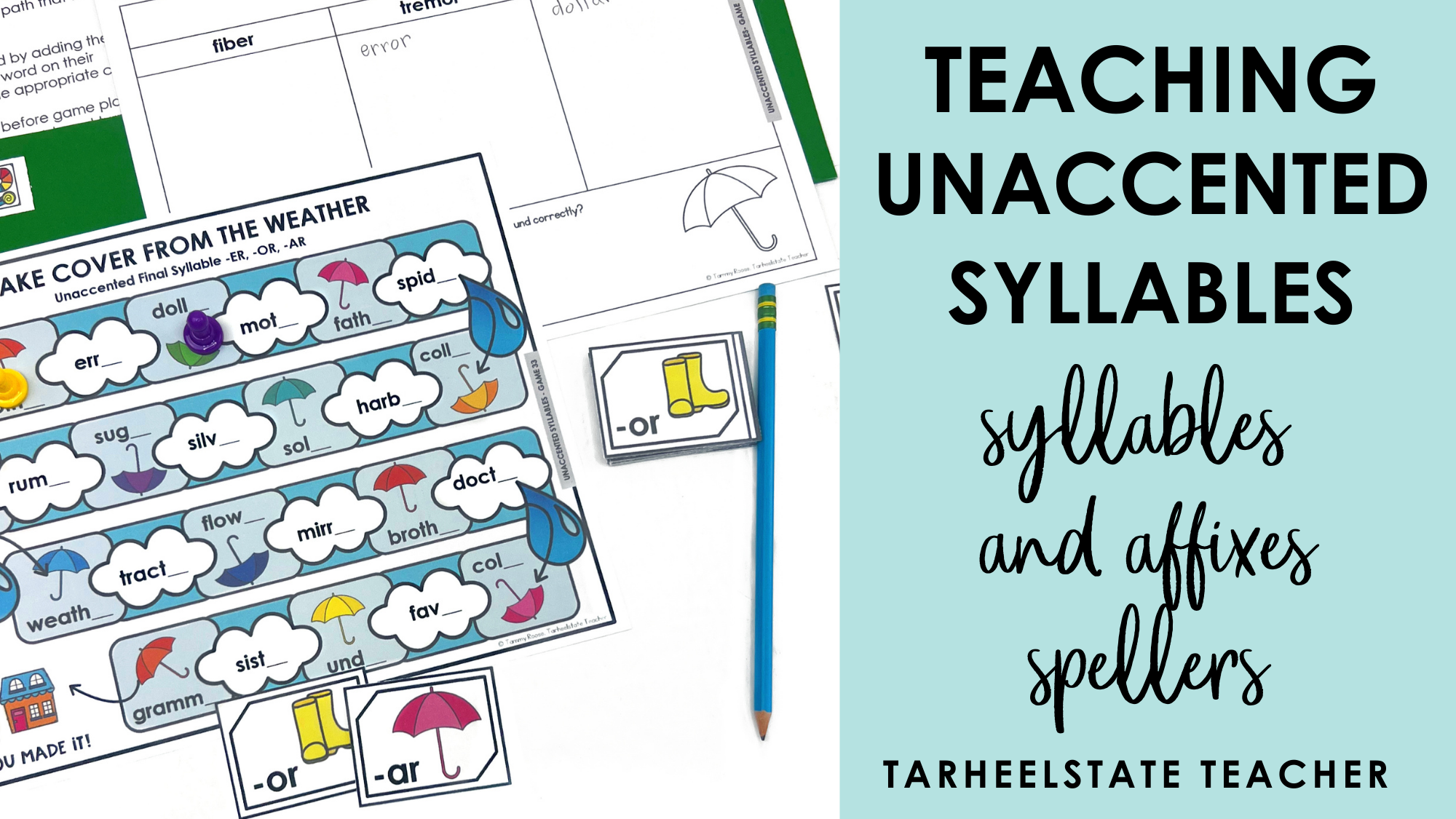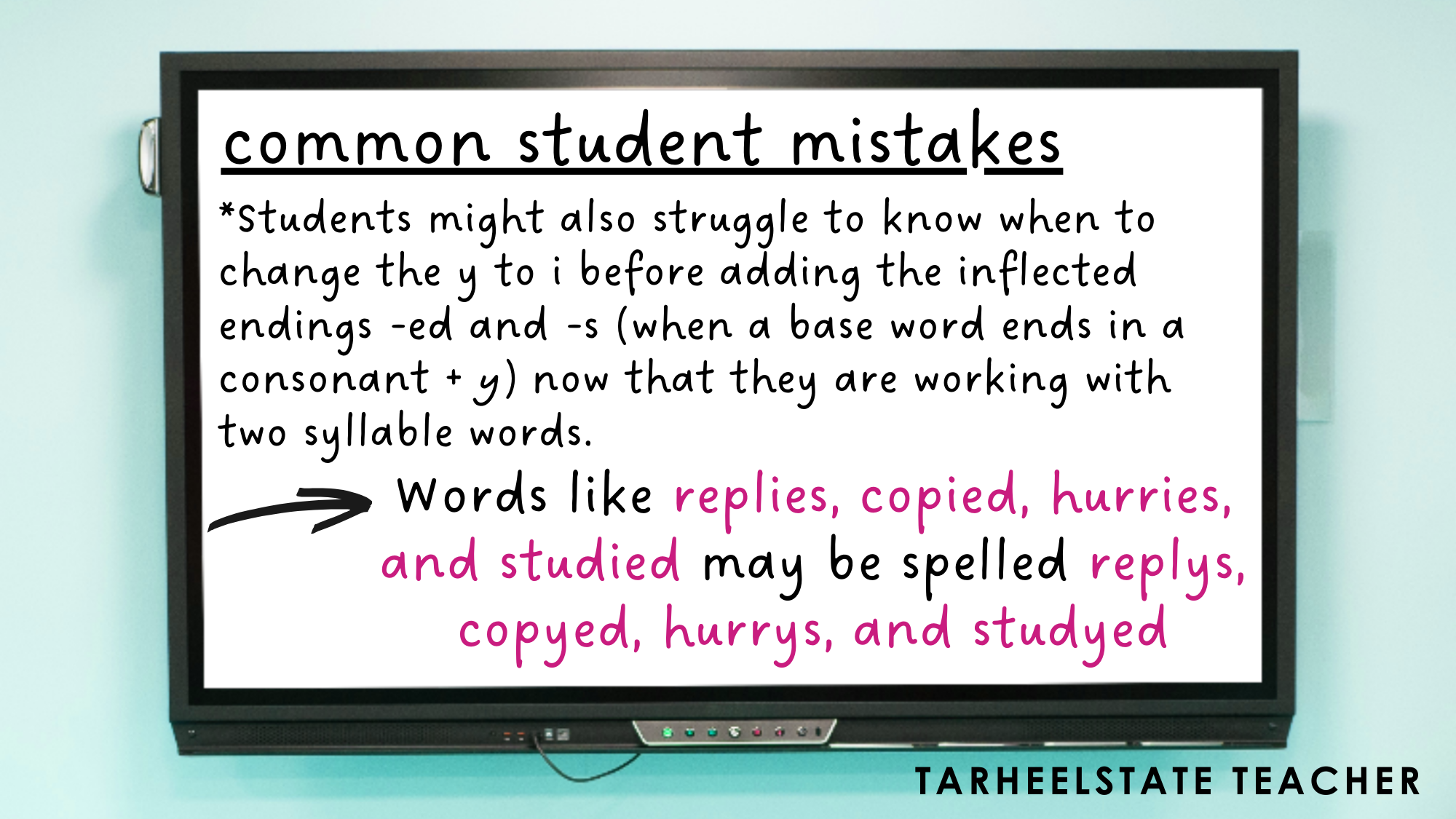Teaching Unaccented Syllables
As upper elementary teachers, we play a crucial role in helping our students develop strong reading and language skills. A part of that job entails giving our students the tools they need to to fluently read and write multisyllabic words, not just ones they are currently studying on their word lists, but new and unfamiliar ones they will encounter as their reading and language skills continue to improve.
One of those tools is understanding the role syllable types, syllable junctures, and accent in syllables play in forming words. While teaching students to identify accented and unaccented syllables in words may seem trivial at first glance, students having this knowledge is essential for reading fluency, pronunciation, and spelling. In this post, you will find clear definitions and examples of the spelling patterns often found in unaccented or unstressed syllables that you can use with your students (if you’re looking for accented or stressed syllables click here). Even better, you will gain insights on the appropriate timing to introduce these patterns to students and discover effective ways to teach students about unaccented or unstressed syllables, including “ready to use” activities to incorporate into their word study routine. Let’s get started!
What is an unaccented syllable and accented syllable?
Words are composed of syllables that contain a single vowel sound and typically some consonants.
An unaccented syllable, also known as an unstressed syllable, is a syllable that is not emphasized or pronounced with more force than the surrounding syllables in a word or phrase. In English, words typically have one or more syllables that are stressed, while the remaining syllables are unstressed or unaccented.
Syllables within a word that are stressed or accented over others are said slightly louder than the other syllables. In the accented or stressed syllable of a word, one can clearly hear the full vowel sound (whether long or short) while vowels in the unstressed syllables of a word are less emphasized.
The placement of stress on syllables can affect the meaning and pronunciation of words and is therefore important for students to learn the spelling patterns that exist within both accented and unaccented syllables.
What are some examples of unaccented syllables?
Typically students learn to identify unaccented or unstressed syllables in two-syllable words by first identifying the accented or stressed syllable and then looking for the syllable that is deemphasized.
cap/ture - The first syllable is stressed (the "ture" syllable is deemphasized and you can clearly hear the short a vowel sound in the "cap" syllable)
spid/er - The first syllable is stressed (the long i in "spid" can clearly be heard and the second syllable, “er”, is unstressed).
cattl/le - The first syllable is stressed (the short a sound in the "catt" syllable is full heard and emphasized over the "le unstressed syllable)
fin/al - The first syllable is stressed (the long i sound in the "fin" syllable is fully heard and emphasized over the "al" unstressed syllable)
What are the unaccented or unstressed patterns that students typically start to learn first?
When students have mastered short and long-vowel patterns, r-controlled vowel patterns, ambiguous vowel patterns, and diphthongs in a variety of one-syllable words, they are ready to shift their focus on two and three-syllable words. Then, getting a solid understanding of syllable junctures becomes important and starts to pave the way to begin studying accented and unaccented syllable patterns.
After learning how to identify accented syllables, it makes sense to start with introducing the most commonly used final and initial unaccented or unstressed syllable patterns, such as the first syllable of again or the final sound in cradle or marble. In the Syllables and Affixes stage, Words Their Way focuses on the following unaccented syllable patterns:
Unaccented Final Syllable (-LE) - cradle, maple, giggle, puddle, tickle, jungle
Unaccented Final Syllable (-LE, -EL, -IL, -AL) - cattle, pebble, level, novel, fossil, evil, metal, oval
Unaccented Final Syllable (-ER, -OR, -AR) - sister, flower, motor, rumor, solar, dollar
Agents and Comparatives (-ER, -OR, -AR) - writer, actor, beggar, longer, fresher, smoother
Unaccented Final Syllables (/CHUR/ and /ZHUR/) - catcher, teacher, picture, creature, measure
Unaccented Final Syllables (-EN, -ON, -AIN, -IN, -AN) - broken, captain, carton, napkin, human
Unaccented Final Syllables (-ET, -IT, -ATE) - jacket, quiet, orbit, limit, pirate, senate
Final -Y, -EY, and -IE - money, journey, cookie, goalie, twenty, story, deny*, reply*
*Sometimes the y represents the long i sound in a final accented syllable.
Y + Inflected Endings - obeying, enjoyed, replying*, studied, carries, decays*
Unaccented Initial Syllables (A-, DE-, BE-) - away, afraid, degree, develop, believe, beyond
* Note: I've linked each of these spelling patterns in unaccented or unstressed syllables to resources that can be used to teach these skills. You can find the bundle for teaching Unaccented Syllables here.
In what grade-level are unaccented syllables taught?
Teaching final and initial spelling patterns in unaccented syllables is developmentally appropriate for students in the middle of the Syllables and Affixes stage. These students have a strong foundation of knowing and accurately using long-vowel patterns and other vowel patterns in one-syllable and two-syllable words, however, frequently make mistakes when spelling the vowel sound, which is often the schwa sound in unaccented syllables.
Syllables and Affixes students are typically in 4th-5th grade, but you may find that some 3rd grade students are ready for this stage.
What are some common mistakes students make when reading and spelling unaccented syllables?
Students tend to have an easier time grasping accented syllables because the vowel sound is clearly heard and therefore often easier to spell. Unaccented syllables however often contain the schwa sound /ә/, as in the first syllable in afraid or the final sound in cable or pencil. These can pose some difficulties for students because the same sound is spelled in several different ways. Therefore, spelling errors can be plentiful before students memorize the spelling of some of these words.
Example → Words like angle, nickel, pencil, and total may be spelled angal, nickle, pencel, and totil
Students might also struggle to know when to change the y to i before adding the inflected endings -ed and -s (when the base word ends in a consonant + y) now that they are working with two syllable words.
Example → Words like replies, copied, hurries, and studied may be spelled replys, copyed, hurrys, and studyed
How do you teach unaccented syllables?
Although unaccented syllables can often be a bit of a roadblock for many students, there are a couple of things teachers can do to help light the way in leading their students to mastery of spelling and reading words with these unaccented syllable patterns.
Knowledge is Power
First, teach them more than just the spelling patterns for each sound. Make sure that lessons and word work activities are asking students to repeatedly identify how many spelling patterns there are for a specific unaccented syllable sound and identify them. For example, when students learn that the final syllable /әl/ can be spelled four different ways (-le, -el, -il, -al), they are less apt to haphazardly pick the first representation of the final syllable sound that comes to mind. Instead, they are able to thoroughly pause and think about which spelling pattern should be used for a particular word.
Second, choose sorting and word work activities that highlight the prevalence of one unaccented syllable spelling pattern over the other. Although the best path to mastery of learning all the spelling patterns for unaccented syllables is through activities and experiences that lead to memorization of the spellings of words, there are specific unaccented syllable spelling patterns that tend to occur more frequently. For example, -er is much more common than the endings -or or -ar. Additionally, -le is much more commonly found in final syllables than –el, -il, or -al. Directly teaching students which ones are more prevalent than others can help them make a more educated guess when they aren’t sure which spelling pattern to choose.
Repetition is Your Friend
Because a large part of achieving mastery with identifying and spelling unaccented or unstressed syllables is due to memorization, it is important to provide a wide variety of spelling and word work activities that engage students in these skills. I find that doing the same sort or activity over and over doesn’t really lead to memorization, just boredom. So I like to use a plethora of experiences and activities like sorting, matching activities, word searches, buddy quizzing, and even interactive partner games and independent center activities to keep students interested and engaged, while really honing in on the teaching strategies I mentioned above.
I love using board games like, Take Cover from the Weather, to give students opportunities to choose the correct unaccented syllable to complete the word. By leaving off the final syllable, students must engage their orthographic mapping skills to picture the correct spelling of the word, whether it “looks” right ending in -er, -or, or -ar.
I also LOVE using interactive activities like, Layer On, to give students repeated practice spelling the unstressed syllable patterns in a fun and exciting way. In this activity (which I use for all unaccented syllable patterns) students spin the spinner to get a spelling pattern. They then must find a card that makes a complete word when paired with the final syllable they spun. Students then record the word they created on their recording sheet and add it to an existing word tower and start a new one. The player with the most words in a single word tower wins. This activity requires students to spell each particular word included in the game three times, helping their memorization skills.
These games are just a few of many! You can find all of the games and activities I suggest using in the Unaccented Final Syllables Games and Activities Bundle.
YOU’VE GOT THIS!
Again, because students really need to memorize these unaccented syllable spelling patterns, the more repeated and varied practice you provide them, the better spellers and readers they will become. Happy Teaching, my friend!
Looking for more Syllables and Affixes Resources?
You can get all of the Syllables and Affixes Stage games and activities in a time-saving , money saving bundle!







